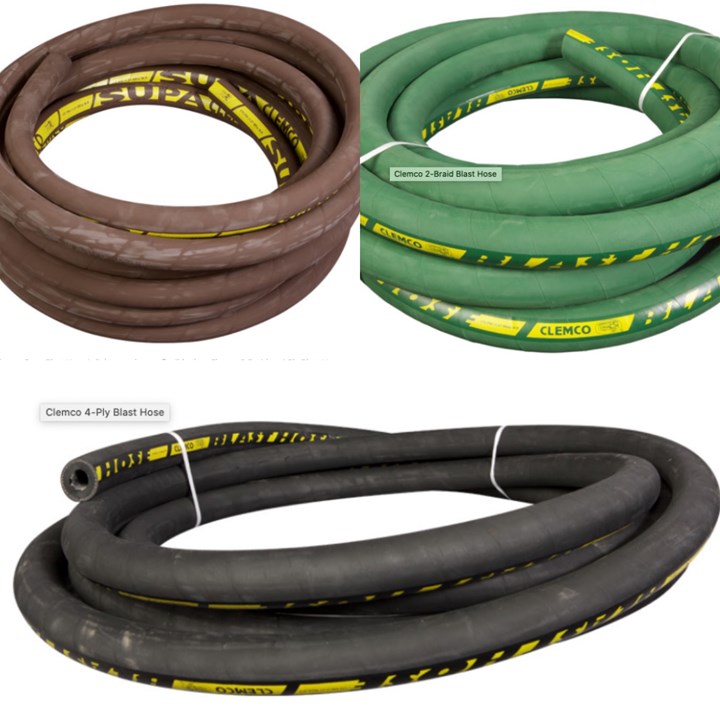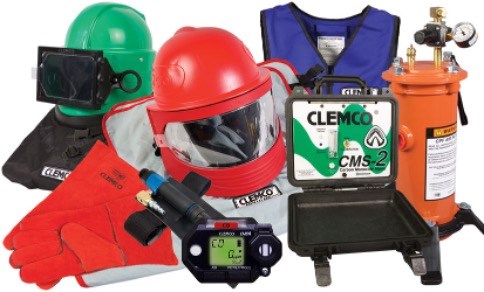Tips for Choosing Abrasive Blasting Safety Equipment and Safety Procedures
Selecting new blasting equipment? Lane Barnholtz of Clemco Industries, manufacturer of air-powered abrasive blasting equipment, offers insights for choosing the correct equipment for your needs.
Q: I’m planning to add blasting capabilities as part of an expansion of my facility. What considerations do I need to keep in mind as I select blasting equipment?
It’s a cliché, but it’s true: To do a job right, you need the right equipment. This is especially true for abrasive blasting.
The information that follows outlines how to evaluate which safety equipment and safety procedures are best for a typical abrasive blasting job. However, before choosing equipment or establishing safety procedures, evaluate the target surface and the worksite environment, perform a job hazard analysis, and assess the goals of the job.
1. Blast Hose and Couplings
Always use an appropriately sized, good quality, static-dissipating blast hose that is manufactured for abrasive blasting and rated at the appropriate working pressure. The blast hose ID should be at least three times the size of the nozzle orifice.

Blast hoses can come in different sizes. A standard hose (top left) is lighter and more flexible than 2-braid (top right) and 4-ply (bottom) hoses, which offer added durability for use in industrial settings where external scuffing is expected.
Photo Credit: Clemco Industries
2. Operator Safety Equipment
Personal protective equipment (PPE), including NIOSH-approved respiratory protection, is necessary for workers using blasting equipment, as well as for everyone in the work area. No dust is safe to breathe! Use an air-fed helmet that not only furnishes breathing air but that also muffles noise, allows an unobstructed field of vision, and protects the operator’s head and face from rebounding abrasive.
Additional operator safety equipment may include air filters, safety cables, couplings, air pumps, light-duty and heavy-duty blast suits, Beacon Blast Lights, screens, supplied-air respirators, and more. Consult your supplier to help assess what you need for safe, comfortable, compliant abrasive blasting,

Operator safety equipment comprises a variety of gear including protective clothing, respirators, air filters and more.
Photo Credit: Clemco Industries
3. Carbon Monoxide Monitor-Alarms
These devices trigger audible, visual and/or vibratory alarms after they detect unsafe levels of carbon monoxide (CO) in the breathing-air supply of a supplied-air respirator. CO can be produced by oil-lubricated compressors or by motor or engine exhaust that enters the intake of a compressor or ambient air pump.
Various types of carbon monoxide monitor-alarms are available from wall-mountable alarms to portable models for use in the field to wearable detectors, such as Clemco’s CMS-4, which is designed to quickly attach inside a respirator helmet and to enable operators to self-monitor their carbon monoxide exposure.
4. Properly Prepared Operators + The Right Equipment = Successful Abrasive Blasting
Just like any other task in life, knowledge, experience, and proper training are essential to abrasive blasting. OSHA regulations state that employers are responsible for training operators and for supplying all necessary PPE. Employers also must establish a safety program and ensure that their workers follow safe practices on every job. OSHA’s regulations reinforce that the best way to guarantee a safe, efficient, and productive abrasive blasting operation is to use properly trained, properly protected operators who have the right equipment for the job.
For more information about efficient and safe abrasive blasting, download the following free eBooks from Clemco Industries:
- Abrasive Blasting Safety Practices
- Blast Off 2
- 3 Tips for Avoiding Poor Blast Machine Performance
Download the eBooks: clemcoindustries.com/free-books
About the Author
Related Content
Anodizing for Bonding Applications in Aerospace
Anodizing for pre-prep bonding bridges the gap between metallic and composite worlds, as it provides a superior surface in many applications on aluminum components for bonding to these composites.
Read MoreHow to Address Declining Powder Coating Coverage Over Time
Fine particles from reclaim could be to blame for powder coating problems that emerge over time. Avoid problems by keeping hooks clean, maintaining guns and using reclaim powder quickly to avoid accumulation of fines.
Read MoreSolvent Versus Aqueous: Busting the Myths
Is aqueous cleaning “greener” than solvent cleaning? Is solvent a more effective cleaner than aqueous? These and many other questions are answered here to debunk the misconceptions that many manufacturers have held onto for years.
Read MoreRead Next
A ‘Clean’ Agenda Offers Unique Presentations in Chicago
The 2024 Parts Cleaning Conference, co-located with the International Manufacturing Technology Show, includes presentations by several speakers who are new to the conference and topics that have not been covered in past editions of this event.
Read MoreEpisode 45: An Interview with Chandler Mancuso, MacDermid Envio Solutions
Chandler Mancuso, technical director with MacDermid Envio discusses updating your wastewater treatment system and implementing materials recycling solutions to increase efficiencies, control costs and reduce environmental impact.
Read MoreDelivering Increased Benefits to Greenhouse Films
Baystar's Borstar technology is helping customers deliver better, more reliable production methods to greenhouse agriculture.
Read More














.jpg;maxWidth=300;quality=90)







